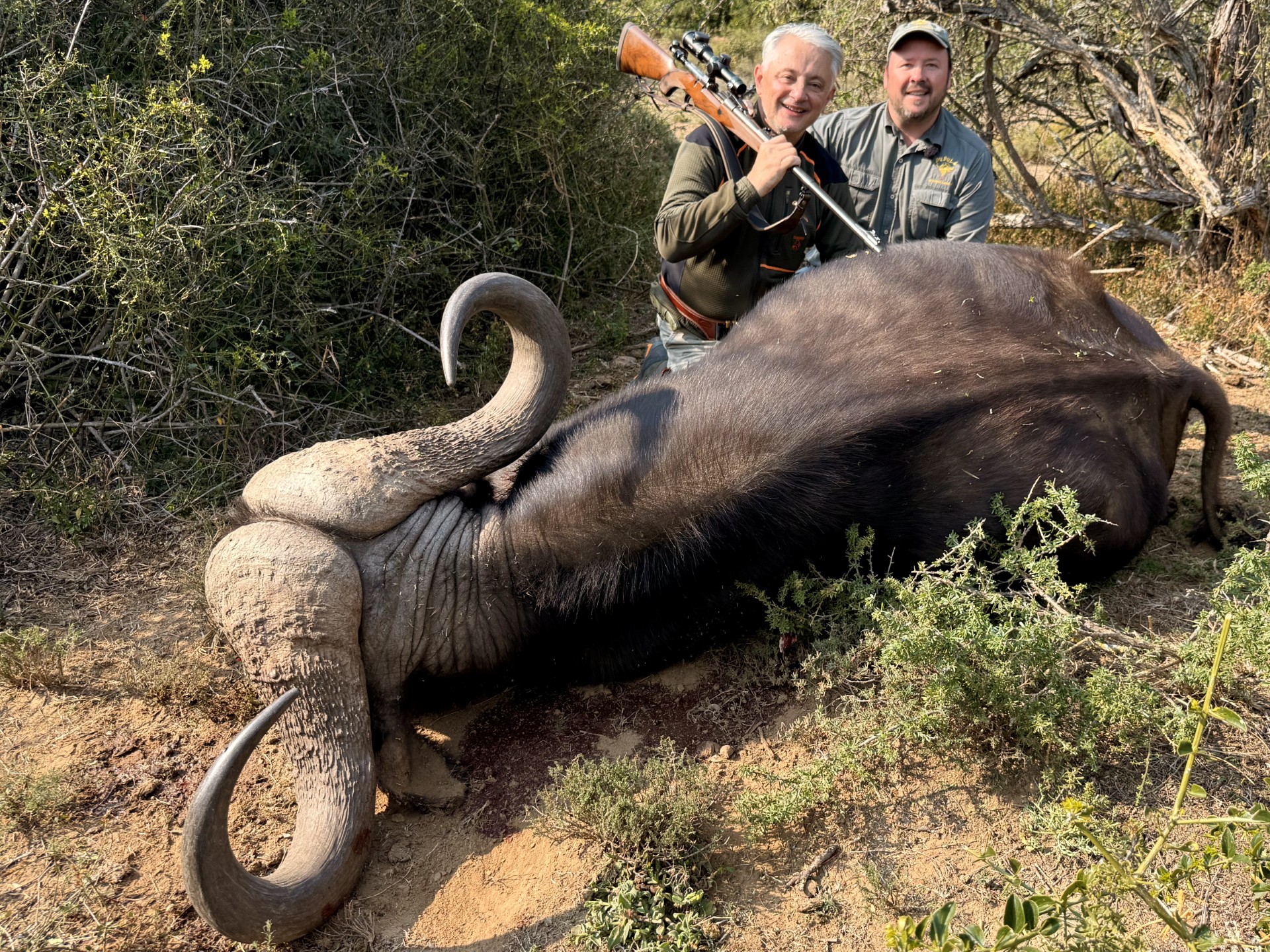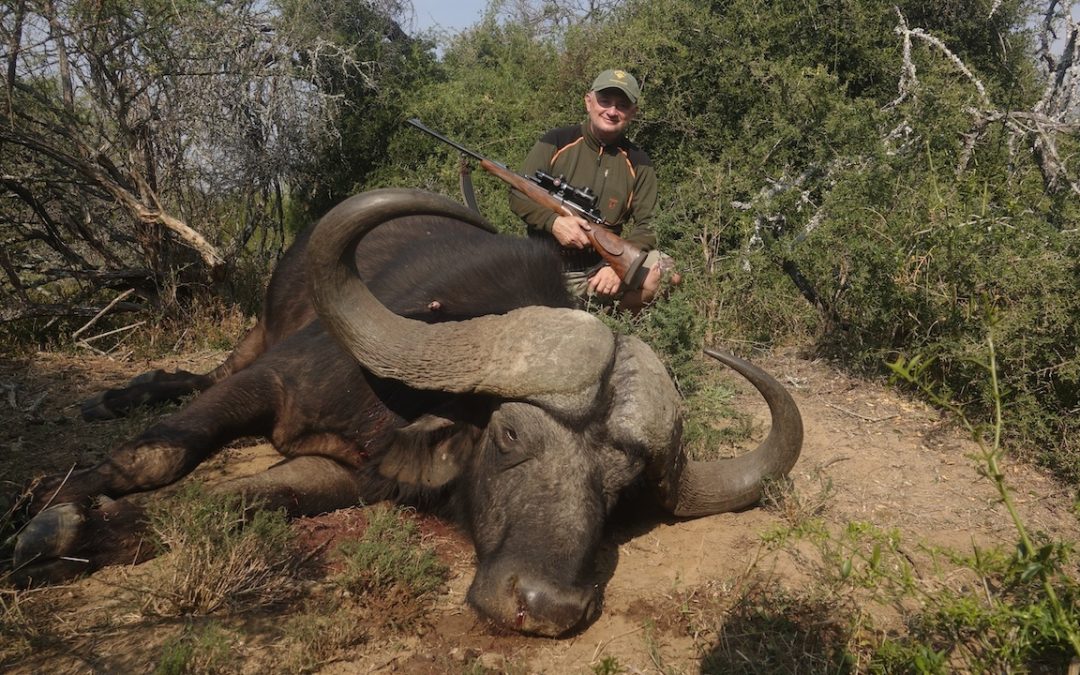By Alessandro Cabella
“Moments like these are what make hunting so deeply meaningful – not just the pursuit, or the danger, or the kill – but the partnership with the land, the species, and the timeless rhythm of survival.”
A Legacy of the Land
I remember it clearly: the light just before dawn in Kamala, near East Somerset. The sky – painted in tones of violet and grey – slowly gave way to soft streaks of pink, as if reluctant to reveal the secrets hidden in the bushveld. I was back in South Africa for my third hunt with Ryan Beattie of Dubula Hunting Safaris, and although I had walked this land before, something about this trip felt different. After twenty years of hunting in South Africa, the anticipation hadn’t faded – it had only matured. Experience teaches a hunter many things: patience, precision, and above all, humility. This wasn’t just another trip. This was a return to a place that shaped me, and I felt in my bones that the land was about to test me once again.
Gear Used on This Hunt
Rifle: .416 Rigby
Ammunition: 400-grain soft point
Optics: Leica Magnus 1-6x24mm scope with illuminated reticle
Outfitter: Dubula Hunting Safaris
PH: Ryan Beattie
Location: Kamala, Eastern Cape, South Africa
Target Species: Cape Buffalo (Syncerus caffer)
Shot Distance: Approx. 60 yards
Conservation Status: Least Concern (IUCN), with population control supported through ethical hunting
The Journey to Kamala
Before arriving in Kamala, we had explored several concessions – each with its own terrain and tempo. Some were open and sun-scorched, while others offered shaded valleys teeming with life. Kamala itself, nestled near East Somerset, is a region of contrasts: thick bush alternates with rocky clearings, and tall grasses sway beside ancient trees like acacia and marula. In the early morning, the air bites with cold and carries the sharp scent of dew-soaked soil. But by midday, the sun bears down, the wind shifts, and the bush changes entirely – animals move into deeper cover, and the silence becomes thick, almost sacred. It’s the kind of land where your senses stay on edge, even when the rifle is at rest. We made camp with careful planning. Ryan, ever the strategist, mapped our movements around recent animal activity, fresh spoor, and wind direction. No shortcuts. No rushing the process. That’s something I’ve always appreciated about hunting with him—each decision is driven by respect for the animal and the environment.
Tracking the Old Warrior
For two days, we tracked a particularly large Cape buffalo – an old bull whose massive hoofprints and wallows told a story of age, strength, and survival. The buffalo is a symbol of raw, untamed power. They’re not to be underestimated. When wounded or cornered, they become incredibly dangerous. But when observed with patience, they become something more: a mirror of the land’s resilience. Our mornings began in darkness, with boots damp from dew and breath misting in the cold air. With Ryan and a pair of skilled local trackers, we followed fresh dung, flattened grass, and hoof impressions along watering routes and feeding areas. The buffalo had circled back at least once, doubling back in a way that revealed its experience. He was testing us as much as we were tracking him. We remained silent for hours at a time, communicating with small gestures and hushed whispers. We paused to glass open areas. We read the terrain, the light, the wind. The .416 Rigby rested comfortably in my hands – its weight familiar, its purpose clear.
The Shot That Echoed
It was early on the second morning when it happened. We had tracked the bull to a low rise overlooking a thicket where buffalo often bed down. The terrain dipped gently, offering natural cover. As the first light crept through the trees, the shape of the bull emerged – massive, deliberate, and unmistakable. Even at a distance, you could see he was an old warrior. His horns were thick and deep-curved, worn and pitted by years of life in the wild. Scars marked his hide – evidence of past battles with predators and perhaps other bulls. Ryan leaned close and whispered, “Forty-five inches at least.”
The wind held steady. The distance was perfect. My breathing slowed. I took position, steadied the Rigby, and focused. When I squeezed the trigger, the shot cracked through the morning silence – echoing against the hills. The buffalo dropped immediately. A clean, vital hit. No suffering. No second shot. We approached slowly. Even when they fall, Cape buffalo demand caution. But it was over. The great beast lay still. Up close, he was even more impressive – muscle, horn, and age carved into one formidable animal.

The Moment After
The silence that follows a successful hunt is unlike any other. It isn’t triumphant. It’s reverent. We stood over the bull quietly, absorbing the gravity of the moment. I knelt and placed a hand on his hide. I thanked him. Not out of ritual, but out of real respect. He had lived a full, hard life. He had earned this dignity. The trackers and guides joined us, and together we processed the animal with care. In the tradition of ethical hunting, nothing was wasted. Meat, hide, horns – all accounted for. The story of that buffalo would live on, not just in memory or trophy, but in sustenance for many.
Campfire Reflections
That night, under a vast African sky ablaze with stars, we gathered around the fire. The air buzzed with the sounds of the bush—hyenas laughing in the distance, insects humming like a chorus. We ate well, told stories, and shared laughter. But for me, the moment was still sinking in. I’ve hunted across continents. I’ve pursued everything from antelope in Namibia to red stag in Argentina. But something about South Africa holds me in a different way. It’s not just the terrain or the game – though both are exceptional. It’s the depth of the experience here. The connection between hunter, guide, and land feels ancient, sacred. And with Ryan Beattie and the team at Dubula Hunting Safaris, it always feels purposeful. Every hunt is approached with professionalism, ethics, and an understanding that we are guests here. The animals, the trackers, the bush – they are the hosts.
20 Years of Lessons
Two decades of hunting in South Africa have taught me that the true essence of the hunt is never the shot. It’s everything before and after – the months of preparation, the hours of tracking, the split-second decisions, the lessons from failed attempts, the campfire conversations, the stories passed down. Over the years, I’ve seen seasons change. Herds migrate differently. Rainfall shift. Predators adapt. I’ve seen what happens when conservation is handled poorly – and what happens when it’s handled well. Ethical hunting, when practiced responsibly, supports anti-poaching initiatives, funds habitat preservation, and sustains local communities. This hunt – harvesting that 45-inch buffalo – was the culmination of years of growth, both as a hunter and as a human. But it wasn’t an ending. If anything, it renewed my sense of responsibility: to do more, to give back, and to protect the wild places that have given me so much.
Final Thoughts
What we take from the land must always be matched by what we give. And as I look back on this unforgettable adventure in Kamala, I carry more than just a trophy. I carry a story of pursuit, partnership, and profound respect – for the animal, the people, and the place. This memory – etched in dust, smoke, and stars – is one I will revisit often. And when I do, I’ll hear the wind over the ridge, feel the weight of the rifle in my hands, and remember the stillness that came after the shot. A lifetime memory, made once again in my favorite country: South Africa.

